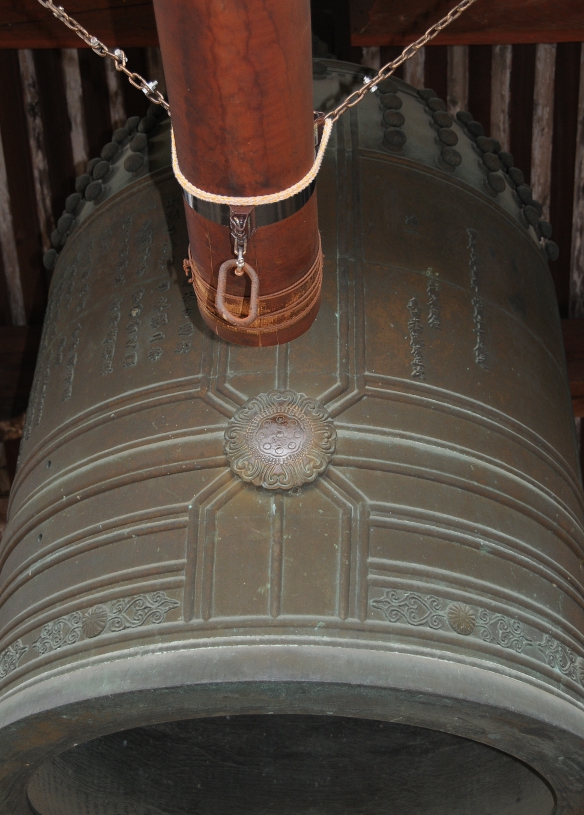In Japan, the New Year is the most important holiday. It is celebrated with efforts the West reserves for Christmas. There are lots of routines, rituals, and traditions surrounding New Year’s in Japan, so I will focus on the two things I did myself this time.
Joya-no-Kane
Like in Austria, where the large bell of the Stephansdom in Vienna rings in the New Year, temple bells play an important role in Japanese New Year’s Eve. In a ceremony called joya-no-kane, Buddhist temples all over the country ring their large bronze bells. It depends on the temple how formally this is done; for example in Kyoto’s Chion-in, one of the most famous spots for the ceremony, the bell is rung exclusively by the monks of the temple, whereas in many smaller temples, even normal people can ring the bell. In any case, the bell is struck 108 times at New Year’s Eve – once for each of man’s earthly desires which, according to Buddhism, cause suffering. Each time the bell is rung, one desire is eliminated from those who listen, so they can start the New Year with a clean slate.
 A Buddhist temple bell is a huge affair, the one in Chion in being 3.3 metres high, 2,7 metres in diameter, and 70 tons heavy. It is rung – or rather, struck – from the outside with a large wood beam, and it takes 17 people to do so. The sound of such a temple bell is very loud and deep, it carries a long way and when you are close enough, it resonates deep within your body. Only when the tone has completely stopped, the bell is struck again – so, the larger the bell, the longer the joya-no-kane will take. The starting time depends on the temple. In Chion-in it is timed so that the 108th strike happens in the New Year. Other temples have different rules. This time, I could year temple bells from around 11 pm to 1:30 am approximately.
A Buddhist temple bell is a huge affair, the one in Chion in being 3.3 metres high, 2,7 metres in diameter, and 70 tons heavy. It is rung – or rather, struck – from the outside with a large wood beam, and it takes 17 people to do so. The sound of such a temple bell is very loud and deep, it carries a long way and when you are close enough, it resonates deep within your body. Only when the tone has completely stopped, the bell is struck again – so, the larger the bell, the longer the joya-no-kane will take. The starting time depends on the temple. In Chion-in it is timed so that the 108th strike happens in the New Year. Other temples have different rules. This time, I could year temple bells from around 11 pm to 1:30 am approximately.
Hatsumode
Once the joya-no-kane is over, it is time for your hatsumode, the first shrine visit of the year. People go and make their first prayers, buy new Omamori charms of various types (from general luck charms to getting married and easy delivery), and buy O-mikuji, their “personal” fortunes for the New Year. Those fortunes are either paper strips directly pulled out of a jar, or you draw a piece of wood with a number on it in exchange for the fortune strip. There are both luck and curse fortunes of various degrees, and a neutral one. No matter which one you draw, it is best to leave it at the shrine, tied to a pine tree if possible. A curse will stay at the shrine and wait for your return, and a good luck will multiply for you at the shrine. Especially now this is popular, I have never seen such masses of O-mikuji tied to twigs around shrines…
 In Kyoto, the most popular shrines for hatsumode are Yasaka jinja, Heian jingu, and Fushimi-inari Taisha. As you should perform your hatsumode as soon as possible after New Year, these places are packed with people. I have heard that Fushimi-Inari alone drew 2.5 million visitors in the first three days of this New Year…
In Kyoto, the most popular shrines for hatsumode are Yasaka jinja, Heian jingu, and Fushimi-inari Taisha. As you should perform your hatsumode as soon as possible after New Year, these places are packed with people. I have heard that Fushimi-Inari alone drew 2.5 million visitors in the first three days of this New Year…
My New Year? I went with my housemates to Shinyodo temple where we were allowed to ring the temple bell. I did not count, but we must have been cleansing ourselves of desire #35 or somesuch, hopefully something serious. After having some of the hot tea served there by the monks (it was freezing…) we went to Yoshida shrine for our hatsumode. I did not buy a charm, but I prayed for a new job – you’ll never know. Anyway, as fireworks are forbidden in Kyoto, the New Year came very quietly, without making a huge entrance like in the West. I liked it, it very much matches my own style…
